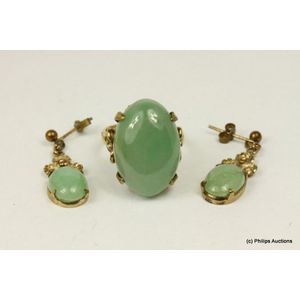Opal and Diamond Cocktail Ring with Loose Stones
You must be a subscriber, and be logged in to view price and dealer details.
Subscribe Now to view actual auction price for this item
When you subscribe, you have the option of setting the currency in which to display prices to $Au, $US, $NZ or Stg.
- Brilliant Cut - In their naturally occuring state diamonds have little life or sparkle and for many centuries were simply cut in half and worn in amulets. Invented at the end of the 17th century by a Venetian diamond cutter, a "brilliant cut" diamond has 58 facets arranged in a regular geometric relationship, with 33 above the crown and 25 below on the pavilion.
The introduction of the brilliant cut increased the popularity of diamonds in jewellery as it was the first cut to reveal the fire of the diamond, with the light being internally reflected from one facet to another, and was superior to the previously used table cut and rose cut.Variants to the brilliant cut have emerged since the end of the 17th century, but the popularity of the original brilliant cut has continued to the present time, where it is still the most commonly found cut.
. - A/f, as Inspected - The letters "A/F" or "as inspected" as part of a description is the cataloguer's shorthand for "all faults" or "as found", meaning the item has some type of damage or deficiency, it is of uncertain date or provenance, and/or that the seller takes no responsibility for the completeness of the item or the accuracy of the description.
- Circa - A Latin term meaning 'about', often used in the antique trade to give an approximate date for the piece, usually considered to be five years on either side of the circa year. Thus, circa 1900 means the piece was made about 1900, probably between 1895 and 1905. The expression is sometimes abbreviated to c.1900.
This item has been included into following indexes:
- rings, diamond solitaire - diamond solitaire / claw set brilliant cut 6,883
-
rings, types
- cocktail 726
- dress, gold 2,430
- rings, with sapphires - sapphire and opal 35
Visually similar items

Green amber and peridot bracelet

Twenty-one loose oval and pear shaped white opals, all solid white opals, varied in intensity of spectral colours, some of crystal type with stronger colours

A jade ring and pair of jade earrings. 14ct yellow gold, the ring, circa 1960's made as a large solitaire styled dress piece, set with an oval cabochon jade of pale green colour, claw set in a geometrically worked gallery on simple band, along with a pair

A jade jewellery suite, comprising a bracelet set with five oval panels of carved jade, together with a large conforming ring, all in 14ct gold, ring size P-Q.
